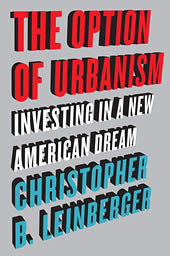Presentation by Henry Cisneros
 Yesterday was the third conference on "Walkable Urban Communities" with the topic of "Social Equity and Walkable Urban Places," held by the GWU Center for Real Estate and Urban Analysis, featuring the ongoing research project spearheaded by Christopher Leinberger, a developer and advocate focused on re-centering more real estate development activity towards "walkable urban places" in the suburbs or the center city, rather than on "drivable suburban" (or "conventional subdivision development").
Yesterday was the third conference on "Walkable Urban Communities" with the topic of "Social Equity and Walkable Urban Places," held by the GWU Center for Real Estate and Urban Analysis, featuring the ongoing research project spearheaded by Christopher Leinberger, a developer and advocate focused on re-centering more real estate development activity towards "walkable urban places" in the suburbs or the center city, rather than on "drivable suburban" (or "conventional subdivision development").The conference was co-produced by the Urban Land Institute with the sponsorship of the Venable Law Firm and LOCUS, a program of Smart Growth America.
The opening presentation was by Henry Cisneros, who was the Secretary of the US Department of Housing and Urban Development under President Clinton, and before that was Mayor (and Councilmember) of San Antonio, Texas.
Since then he has led CityView, a company that builds urban housing as a revitalization strategy, working with funders committed to community investment. I didn't know that he has a PhD from GWU...
My notes from his talk. I won't claim this is verbatim.
There are many factors converging that favor cities as places that attract residents and businesses. At HUD, I worked to refocus the department on urban places. To do so we needed place-based metrics to be able to answer the question "are we making a difference in physical places." (He made the point that the way the federal government is set up, how program authorization and appropriations work, that programs function in ways where it can be difficult to see substantive impact.)
Cities are the platforms for social progress. Cities have the ability to be masters of their own destiny and are the places where government has the real opportunity to make a positive difference in people's lives. Plans and visions make this happen. Many cities have willed their way to a different destiny.
The motive force of a city's agenda is the public good. While cities work with the private sector in public-private partnerships, the agenda of the city is different. It is not motivated by generating profit primarily, even if profit is generated. The primary outcomes are social improvement and equity--the larger public good.
13 trends impacting cities
- Sustainability, both in terms of the impact of climate change (e.g., Superstorm Sandy and the way it impacted New York City and the New Jersey Coast) and the opportunities presented by new building materials
- Embedding technology in urban real estate
- Harnessing new advanced technology businesses (media, information technology, etc.) and anchor instutions like universities and medical centers as engines of urban growth and opportunity
- modernization of urban infrastructure (not just replacing infrastructure, but extending and improving it.
- Mixed income mixing, affordable housing and cross-subsidization
- Preparing for demographic change--the population is aging, and the composition of youth demographics is changing, e.g., starting this year, the majority of the K-12 student population is majority minority
- taking on density--many constituencies oppose this, but in the urban context density is key
- making walkability real
- adding transit related value to communitys
- incorporating public space and amenities into public and private projects as a way to improve them and make them successful
- creative design and modern materials offer new opportunities in construction
- financing of urban real estate development in more creative ways
- cementing public-private partnerships and how they work
Labels: federal policies and the city, metropolitan areas, state government and the city, urban revitalization




0 Comments:
Post a Comment
<< Home